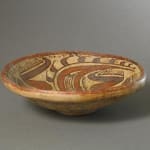Cocle Terracotta Bowl, 800 CE - 1200 CE
Terracotta
9 x 3
PF.4194
Archaeological excavations in the Cocle Province located in Central Panama have revealed that an ancient civilization once inhabited these lands. The findings suggested that the so-called Cocle culture arose around...
Archaeological excavations in the Cocle Province located in Central Panama have revealed that an ancient civilization once inhabited these lands. The findings suggested that the so-called Cocle culture arose around 500 A.D. and lasted until about 1000 A.D. Although their dating is roughly contemporaneous with the Diquis culture to the north in modern day Costa Rica, the art they left behind suggests that they were a unique, independent civilization. Cocle art, which consists primarily of unslipped or buff slipped pottery and terracotta sculptures, is distinguished by their polychrome hues and lively asymmetrical motifs which often include animal themes.
This beautiful bowl demonstrates the skill found in the naturalistic style of decoration. There is only a simple suggestion of zoomorphic interpretation that is based on geometric patterns. The terra-cotta bowl is painted solely on the inside of the piece with beautiful earth tones that include a deep magenta that is popular in this region. The design is simple but very effective. The base allows the bowl to be placed anywhere and not purely hand-held. These forms of artwork demonstrate the pure beauty of simplicity and original form that still remains popular today.
This beautiful bowl demonstrates the skill found in the naturalistic style of decoration. There is only a simple suggestion of zoomorphic interpretation that is based on geometric patterns. The terra-cotta bowl is painted solely on the inside of the piece with beautiful earth tones that include a deep magenta that is popular in this region. The design is simple but very effective. The base allows the bowl to be placed anywhere and not purely hand-held. These forms of artwork demonstrate the pure beauty of simplicity and original form that still remains popular today.
1
of
26



